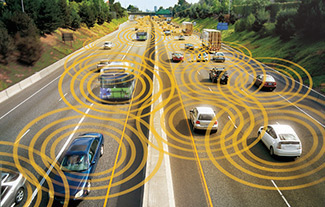 We live in interesting times. I recently saw a report on automobiles becoming totally automated. Hello Jetsons! I’m not sure if this is a good thing or not, but there’s no stopping existing projects from moving forward at this point. Driving the highway last night I saw a small 2 car accident. The cars were both bashed, one more than the other, and pulled off to the side of the road.
We live in interesting times. I recently saw a report on automobiles becoming totally automated. Hello Jetsons! I’m not sure if this is a good thing or not, but there’s no stopping existing projects from moving forward at this point. Driving the highway last night I saw a small 2 car accident. The cars were both bashed, one more than the other, and pulled off to the side of the road.
A single tow truck was already on sight and it looked like another tow truck company was pulling up as I creeped passed. Lights were flashing and there were two cops at the scene. Fortunately it didn’t appear anyone was injured. I wondered would this have happened if we were all driving automated cars?
What is an automated car? Is it a totally self driving automobile that allows complete hands free driving? Does it act as a robot that we’ve programmed what to do and then just takes us where we want to go? Is it accident proof? Will it be an all electric engine? These are just some of the questions that come to mind when we wonder what the future of road travel has in store for us.
Even with the majority of people not having a real clue about automated vehicles, there is legislation in 4 states and Washington D.C. that now allow driver-less cars. Nevada, Florida, Michigan and Idaho are all forward thinking when it comes to this futuristic form of road travel. Nissan, Toyota, Tesla and Audi are all testing prototypes that they hope to have in the consumers’ garages in a little as five years.
When you research this innovation one of the first sites you’ll come to is the Google Driver-less Car. The self driving car project is currently led by Google engineer Sebastian Thrun and a team of fifteen colleagues. Thrun was co-inventor of Google Street View – something many of us have taken advantage of at one time or another.
Predictions for mass market sales are still 5-10 years away. Certainly by the year 2025 automated cars will be ubiquitous. If they offer safety features that circumvent the human equation it’s predicted that the accident and fatality rate will drop. With so many kinks to work out there’s still a lot of testing to be done. What happens if there’s a snafu if the circuit board and the program freezes up? Can you reboot going 65 mph? Will it revert to manual or will it shut down completely? Will there still be a need for tow trucks? So many questions and the answers are being worked out daily by engineers from all over the world.
There is a push to get the automated car road worthy as soon as possible, saving lives being the chief causative factor. Also a major consideration is the environment and lowering our dependence on fossil fuels along with reducing noise pollution are listed as some of the motivating reasons for transitioning from our old ways. While it won’t be an overnight conversion, even by decade standards the prediction is that by the year 2030 75% of all vehicles on the roads will be fully automated.
Are you ready? I am – the sooner the better. As I get older I want to be mobile until I die. The option to keep us motorized and safe no matter what our age is very enticing, indeed. If I can get in the car, program it – or push one of my pre-set programs to take me where I want to go I’ll be a happy camper.
Relieved of the worry of being a little old lady holding up traffic or afraid to make a left onto a busy street frees me up to live life more fully. There are any number of advantages to an automated automobile, but what are the disadvantages? Check in with me in a future article and we can explore these together.